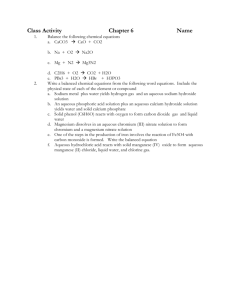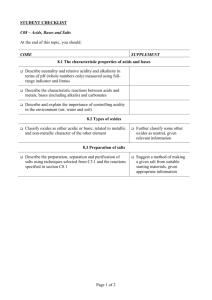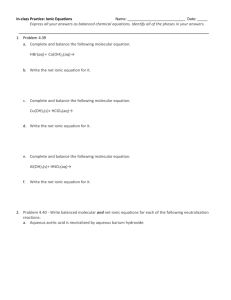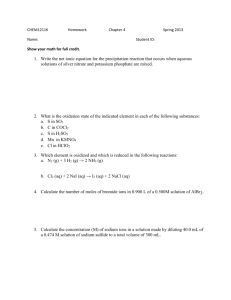Chapter 4: Aqueous Reactions
advertisement
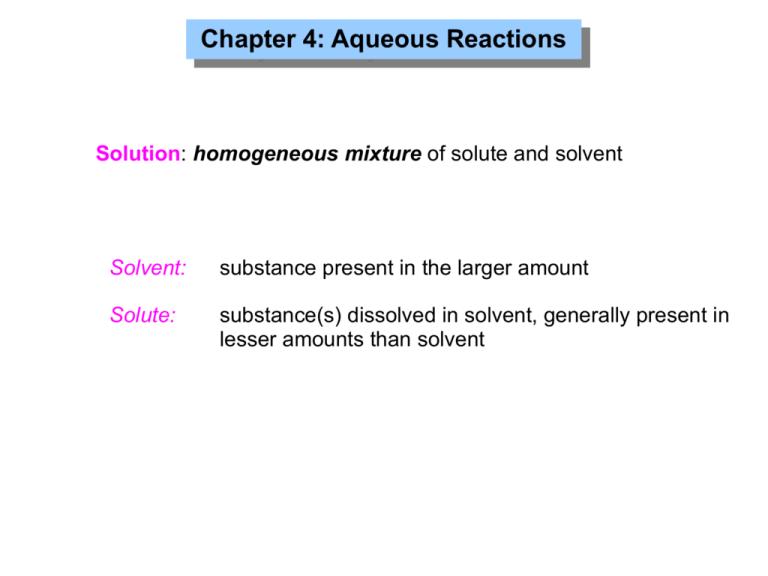
Chapter 4: Aqueous Reactions Solution: homogeneous mixture of solute and solvent Solvent: substance present in the larger amount Solute: substance(s) dissolved in solvent, generally present in lesser amounts than solvent Chapter 4: Aqueous Reactions Ionic Compounds When ionic compounds dissolve in water, they dissociate completely - - + - + - + - + - + + H2O + - NaCl (aq) → Na+ (aq) + Cl- (aq) Chapter 4: Aqueous Reactions Molecular Compounds Most molecular compounds do not dissociate in water + H2O methanol Methanol dissolved in water Chapter 4: Aqueous Reactions Molecular Compounds Some molecular compounds dissociate (ionize) in water (acids) Strong acids, such as hydrochloric acid, dissociate completely: HCl (aq) → H+ (aq) + Cl- (aq) Weak acids, such as acetic acid, dissociate only partially: CH3COOH (aq) H+ (aq) + CH3COO- (aq) Chapter 4: Aqueous Reactions HW: 1,3,18,37 Aqueous solutions that contain ions, conduct electricity Electrolytes: substances that generate ions when dissolved in water For example: Non-Electrolytes: ● Ionic compounds strong electrolyte ● Strong acids strong electrolyte ● Weak acids weak electrolyte ● Strong bases strong electrolyte ● Weak bases weak electrolyte substances that do not generate ions when dissolved in water Chapter 4: Aqueous Reactions Strong, Weak, and Non- Electrolytes AgI NaCl HCl Ag+ Cl- Cl- I- Na+ H+ Ionic Ionic Molecular (dissociated acid) sugar C12H22O11 Molecular Chapter 4: Aqueous Reactions Strong, Weak, and Non- Electrolytes Electrolytes and Non-Electrolyte definition only refers to the molecules/ions that are dissolved Formic acid HCOOH HCOOH+ Molecular Chapter 4: Aqueous Reactions Some reactions involving ionic compounds: Exchange ot Metathesis Reactions +AX + +BY → +AY + +BX Chapter 4: Aqueous Reactions Some reactions involving ionic compounds: Exchange ot Metathesis Reactions If one of the products in insoluble, the reaction is a precipitation reaction: AgNO3 (aq) AgNO3 (aq) + + NaCl (aq) NaI (aq) → AgCl (s) + white precipitate NaNO3 (aq) AgI (s) + NaNO3 (aq) → brownish precipitate Chapter 4: Aqueous Reactions Precipitation Reactions AgNO3 (aq) + NaI (aq) AgI (s) + NaNO3 (aq) → brownish precipitate heterogeneous mixture! Chapter 4: Aqueous Reactions HW: 15 Precipitation Reactions Ni(NO3)2 (aq) + 2 NaOH (aq) I) Identify ions: A: Ni2+ X: NO3- → Ni(OH)2 (s) + 2 NaNO3 (aq) II) Exchange X and Y: A: Ni2+ Y: OHB: Na+ X: NO3 B: Na+ Y: OH III) Determine stoichiometry of compounds formed: Ni2+ + OH- Na+ + => Ni(OH)2 NO3- => NaNO 3 IV) Balance equation! V) Is there an insoluble product? Chapter 4: Aqueous Reactions Precipitation Reactions How do you know which ionic compounds are soluble? Chapter 4: Aqueous Reactions Precipitation Reactions Digest of solubility rules: Salts of the following ions are always soluble: ● Group IA metals ● Li+, Na+, K+ ... ● Ammonium NH4+ ● Nitrate NO3Acetate C 2 H 3 O2 - HW: 10,19,22 Chapter 4: Aqueous Reactions Precipitation Reactions (NH4)2SO4 AgCl CuSO4 FeNO3 Cu(OH)2 CaCO3 LiCl Ca(C2H3O2) 2 HW: 90 Chapter 4: Aqueous Reactions HW: 23 Net Ionic Equations Molecular Equation (shows undissociated compounds): Ni(NO3)2 (aq) + 2 NaOH (aq) → Ni(OH)2 (s) + Ionic Equation: 2 NaNO3 (aq) spectator ions Ni2+ (aq) + 2 NO3- (aq) + 2 Na+ (aq) + 2 OH- (aq) → Ni(OH)2 (s) + 2 Na+ (aq) + 2 NO3- (aq) Net Ionic Equation: Ni2+ (aq) + 2 OH- (aq) → Ni(OH)2 (s) The spectator ions do not participate in the reaction! Chapter 4: Aqueous Reactions Ca(NO3)2 (aq) + Na2CO3 (aq) → CaCO (s) + 2 NaNO3 (aq) 3 Spectator ions: 2 Na+, 2 NO3- Net ionic equation: Ca2+ (aq) + CO32- (aq) → CaCO3 (s) Chapter 4: Aqueous Reactions Ca(NO3)2 (aq) + 2 NaC2H3O2 (aq) → Ca(C2H3O2)2 + 2 NaNO3 Spectator ions: ALL ! If all salts are soluble, no precipitation reaction will take place Chapter 4: Aqueous Reactions Properties of Acids and Bases Acids Bases ● taste sour ● taste bitter ● turn blue litmus red ● turn red litmus blue produce CO2 when reacting with carbonates ● produce H2 when reacting with metals ● generate protons, H+, when dissolved in water ● generate hydroxide ions, OH-, when dissolved in water ● Chapter 4: Aqueous Reactions Properties of Acids and Bases Strong Acids = dissociate completely in water = strong electrolytes HCl Hydrochloric acid HBr Hydrobromic acid HI Hydroiodic acid HNO3 Nitric acid H2SO4 Sulfuric acid HClO3 Chloric acid HClO4 Perchloric acid Chapter 4: Aqueous Reactions Properties of Acids and Bases Strong Bases strong electrolytes Metal Hydroxides of Group IA metals: NaOH, KOH ... Metal Hydroxides of Group IIA metals: Ca(OH)2 , Mg(OH)2 ... HW: 36 Chapter 4: Aqueous Reactions The reaction of acids with carbonate salts: MgCO3 (s) + 2 HCl (aq) → MgCl2 (aq) + H2CO3 (aq) unstable H2CO3 (aq) → CO2 (g) + H2O (l) Overall: MgCO3 (s) + 2 HCl (aq) → MgCl2 (aq) + CO2 (g) + H2O (l) Chapter 4: Aqueous Reactions HW: 39 Neutralization Reactions acid base HNO3 (aq) + NaOH (aq) → WATER salt H2O (l) + NaNO3 (aq) net ionic equation: H+(aq) + NO3- (aq) + Na+ (aq) + OH- (aq) → H2O (l) + Na+ (aq) + NO3- (aq) H+(aq) + OH- (aq) → H2O (l) In a neutralization reaction, an acid and a base react to form water and a salt Chapter 4: Aqueous Reactions Complete and balance the following neutralization reaction: Mg(OH)2 (aq) + 2 HBr (aq) → MgBr2 (aq) + 2 H2O (l) net ionic equation: Mg2+ (aq) + 2 OH- (aq) + 2 H+ (aq) + 2 Br- (aq) → Mg2+ (aq) + 2 Br- (aq) + 2 H2O (l) net: 2OH- (aq) + 2H+(aq) → OH- (aq) + H+(aq) → 2H2O (l) H2O (l) Chapter 4: Aqueous Reactions Concentrations of Solutions ... are measured in Molarity Molarity = moles of solute Volume of solution in L The concentration of 0.4 L of solution containing 0.25 moles of sugar is 0.25 mol mol = 0.6 0.4 L L = 0.6 M Chapter 4: Aqueous Reactions HW: 62,73 Someone is preparing to cook pasta by adding 5.0 g of table salt (NaCl, formula mass = 49.5 g/mol) to 400 mL of boiling water. What is the molarity of the resulting NaCl solution? moles of NaCl M= L of solution (I) convert g NaCl into mol NaCl: 5.0 g NaCl 1mol NaCl 0.10 mol NaCl 49.5 g NaCl (II) calculate molarity: M 0.10 mol NaCl 400 mL × 1000 mL 1L = 0.25 mol NaCl = 0.25 M NaCl L Chapter 4: Aqueous Reactions What is the molarity of Na+ ions in a 0.2 M solution of Na2SO4 ? Na2SO4 (aq) → 2 Na+ + SO42- Na+ SO4 Na+ 2- SO42- Na+ Na+ Each formula unit of Na2SO4 that dissolves gives rise to 1 SO42- ion and 2 Na+ ions + 2 Na 0.2 M Na2 SO 4 × 1 Na2 SO 4 = 0.4 M Na+ Chapter 4: Aqueous Reactions Proton Concentration in Aqueous Solutions [H+] ≡ proton concentration [H+] = 0.001 M pH = -log [H+] [H+] = 0.001 M = 1 x 10-3 M and [H+] = 10-pH pH = -log(1 x 10-3) = 3 [H+] x [OH-] = 10-14 = constant Neutral solution: [H+] = [OH-] = 10-7 M The pH scale 1 acidic 2 3 4 5 6 7 8 neutral 9 10 12 13 14 basic Chapter 4: Aqueous Reactions What are the proton and hydroxide concentrations in a solution that has a pH of 4.3 ? pH = -log [H+] [H+] = 10-pH [H+] = 10-4.3 [H+] x [OH-] = 10-14 [OH-] = 10-14 [H+] = 10-14 = 5.0 x 10-5 Chapter 4: Aqueous Reactions How many moles of HF are needed to make 0.15 L of a 0.13M solution? (how many moles HF are in 0.15 L of a 0.13 M solution?) 1 L of a 0.13 M solution: 0.15 L of a 0.13 M solution: 0.13 mol HF L 0.13mol HF L x 0.15 L = 0.02 mol HF Chapter 4: Aqueous Reactions Dilutions add solvent number of solute molecules before dilution number of moles of solute before dilution M conc = = number of solute molecules after dilution = number of moles of solute after dilution mol solute V conc M conc × V conc M dil = = mol solute V dil M dil × V dil Chapter 4: Aqueous Reactions What is the concentration of a solution that is made by adding 0.3L of water to 15mL of a 0.65M solution? M conc × V conc = M dil × V dil Vconc = 15mL = 0.015L M dil M dil M conc Vconc Vdil Mconc= 0.65M 0.65M 0.015 L 0.315 L Vdil = 0.3L + 15mL = 0.3L + 0.015L = 0.315L 0.031 M Chapter 4: Aqueous Reactions HW: 79a,d Solution Stoichiometry and Chemical Analysis What volume of a 0.30 M HCl solution is needed to completely react 3.5 g of Ca(OH)2 ? 2 HCl (aq) + Ca(OH)2 (aq) → 2 H2O (aq) + CaCl2 (aq) Strategy: 3.5 g Ca(OH)2 → moles Ca(OH)2 molar mass = 74g/mol → moles HCl stoichiometric factor from equation → Liters HCl molarity of solution Chapter 4: Aqueous Reactions Solution Stoichiometry and Chemical Analysis What volume of a 0.30 M HCl solution is needed to completely react 3.5 g of Ca(OH)2 ? 2 HCl (aq) + Ca(OH)2 (aq) → 2 H2O (aq) + CaCl2 (aq) 1mol Ca (OH ) 2 2mol HCl 1L HCl 0.32 L HCl 3.5 g Ca (OH ) 2 74 g Ca (OH ) 2 1mol Ca (OH ) 2 0.30 mol HCl

